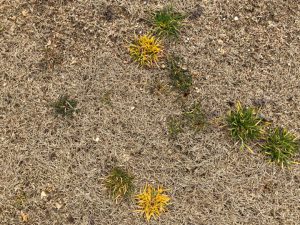Many bermudagrass golf courses in the transition zone wait until January to spray herbicides for annual bluegrass (Poa annua) control. This is the time of year when bermudagrass is at peak dormancy and nonselective herbicides can be used safely for winter weed control. Broadcast applications of glyphosate (Roundup, others) are relatively inexpensive compared to other herbicides that offer better selectivity in bermudagrass after spring transition. Superintendents can also use glyphosate in combination with preemergence herbicides to remove most undesirable weeds and get residual control of annual weeds in late winter and spring.
Last year we visited a golf course in Atlanta that had been spraying glyphosate exclusively for annual bluegrass control every winter for about two decades. Control had become erratic over recent years and segregation of plants was noticeable after glyphosate treatments. Increasing the glyphosate rate was also an ineffective approach to improving results. We collected samples from this golf course, established new plants from seed in the greenhouse, and screened for resistance against a known biotype that was susceptible to glyphosate. The differential tolerance levels to glyphosate among annual bluegrass populations in the greenhouse confirmed the golf course had developed a resistance problem.
There will need to be an emphasis on preemergence programs that prevent the establishment of annual bluegrass with resistance to postemergence herbicides, like glyphosate. Not every turf facility has the resources or scheduling flexibility to apply preemergence herbicides at the ideal timings in fall, and thus, control programs in late fall or winter may be necessary to manage these populations.
Glyphosate resistance takes approximately ten years to establish in turf areas that spray once per year. The onset of resistance will be faster in areas that spray multiple times in the winter due to increased selection pressure. Shifting the population back to biotypes with susceptibility to glyphosate, or “resetting the population”, will likely never occur. Glyphosate can still be used in situations like this, just not exclusively. Popular tank-mixtures may include glyphosate + simazine or a sulfonylurea that offer a second mode of action.
Finale (glufosinate) can be a very effective herbicide for use on dormant bermudagrass. It offers an alternative mode of action to glyphosate and can provide excellent control of annual bluegrass. Sureguard (flumioxazin) is another option for controlling glyphosate-resistant annual bluegrass in dormant bermudagrass. Sureguard is most effective in early winter on immature annual bluegrass. Applications of Finale and Sureguard must be made on bermudagrass that is completely dormant or unacceptable injury or delays in greenup may occur.
If annual bluegrass control continues to be challenging in your turf, programs consisting of herbicides with alternative modes of action to products previously used will be critical. Herbicide rotation can often be difficult due to budgets, turfgrass injury potential, and timings necessary for your events. Let us know how we can help build new programs that work for your facility.
